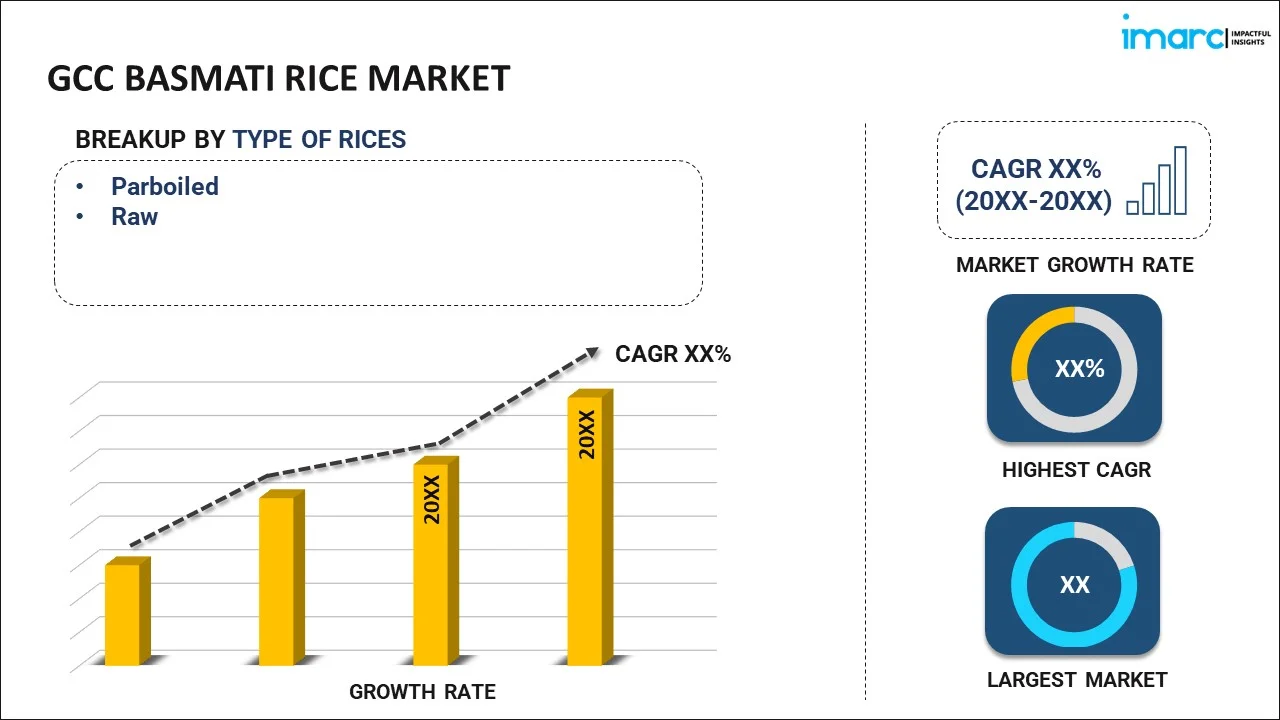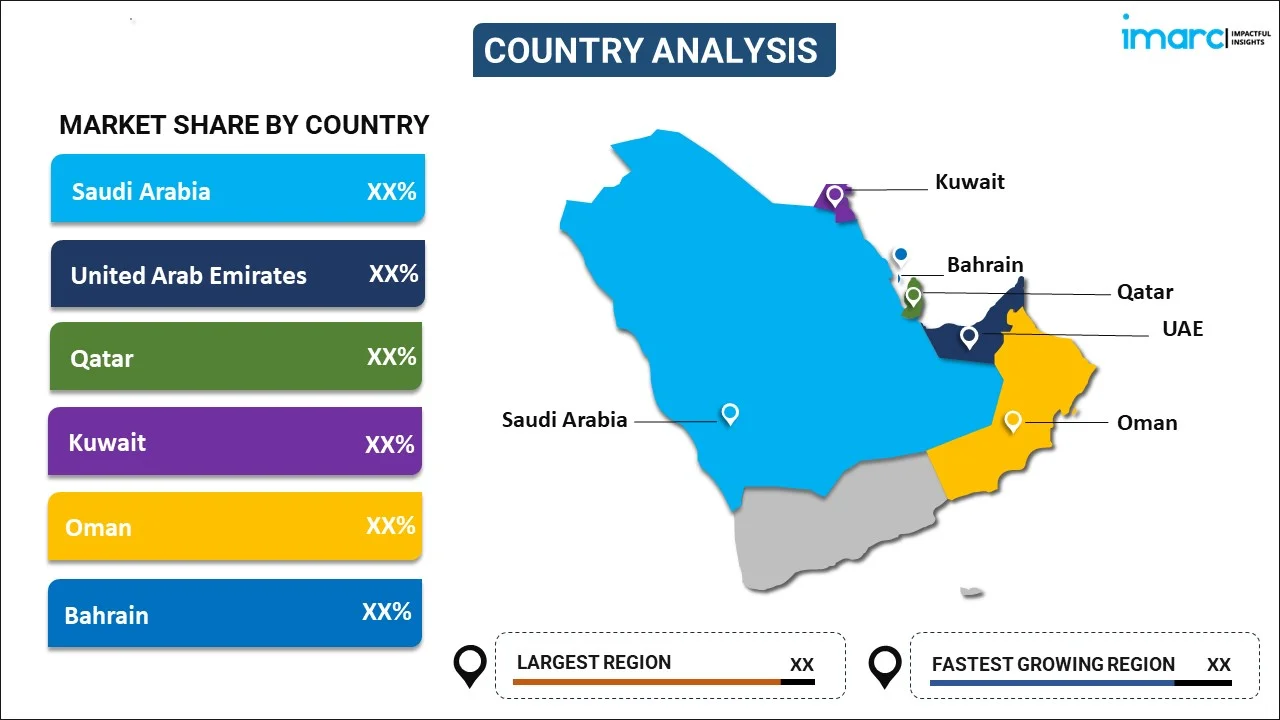
GCC Basmati Rice Market Report by Type of Rice (Parboiled, Raw), Pack Size (Retail Packaging, Institutional Packaging), Country of Origin (India, Pakistan, and Others), and Country 2025-2033
Market Overview:
The GCC basmati rice market size reached USD 1.62 Billion in 2024. Looking forward, IMARC Group expects the market to reach USD 1.76 Billion by 2033, exhibiting a growth rate (CAGR) of 1.0% during 2025-2033.
|
Report Attribute
|
Key Statistics
|
|---|---|
|
Base Year
|
2024 |
|
Forecast Years
|
2025-2033 |
|
Historical Years
|
2019-2024
|
| Market Size in 2024 | USD 1.62 Billion |
| Market Forecast in 2033 | USD 1.76 Billion |
| Market Growth Rate 2025-2033 | 1.0% |
Basmati rice is a long grain aromatic rice grown for several centuries in the geographical area of the Himalayan foothills of the Indian subcontinent. It has slender grains that elongate at least twice from its original size. Moreover, it has a soft and fluffy texture and nutty flavor upon cooking. It is rich in fiber, minerals, vitamins, zinc, copper, proteins, calcium, potassium, magnesium, carbohydrates, and amino and folic acid. At present, it plays a pivotal role in Middle Eastern cuisine, wherein it is utilized in the preparation of several lavish rice-based dishes that comprise layers of rice, meat, sauces, and dried fruits.
GCC Basmati Rice Market Trends:
A lack of rice production in the GCC region on account of unsuitable climatic conditions, in confluence with the escalating demand for better quality rice, represents one of the key factors propelling the growth of the market. Additionally, as basmati rice is considered a staple food in the GCC countries, along with wheat, its export is rising from India and Pakistan. Moreover, a high density of Asian expatriates is driving the overall sales of basmati rice in the region. Apart from this, the growing prevalence of lifestyle diseases on account of lack of physical activities is resulting in the increasing health-consciousness among individuals. As a result, there is a considerable increase in the consumption of brown basmati rice in the daily diet, which has low-fat content and high nutritional value. Furthermore, governing agencies operating in different countries of the GCC region are encouraging abroad investments for the import of rice, which is anticipated to impel the growth of the market.
Key Market Segmentation:
IMARC Group provides an analysis of the key trends in each sub-segment of the GCC basmati rice market report, along with forecasts at the regional and country level from 2025-2033. Our report has categorized the market based on the type of rice, pack size and country of origin.
Breakup by Type of Rice:

- Parboiled
- Raw
Breakup by Pack Size:
- Retail Packaging
- Institutional Packaging
Breakup by Country of Origin:
- India
- Pakistan
- Others
Breakup by Country:

- Saudi Arabia
- UAE
- Kuwait
- Oman
- Qatar
- Bahrain
Presently, Saudi Arabia enjoys the leading position in the market as basmati rice is extensively utilized in the preparation of Kabsa, which is a traditional dish consumed across the country.
Competitive Landscape:
The competitive landscape of the market has been analyzed in the report, along with the detailed profiles of the major players operating in the industry.
Report Coverage:
| Report Features | Details |
|---|---|
| Base Year of the Analysis | 2024 |
| Historical Period | 2019-2024 |
| Forecast Period | 2025-2033 |
| Units | Billion USD, Million MT |
| Segment Coverage | Type of Rice, Pack Size, Country of Origin, Country |
| Countries Covered | Saudi Arabia, UAE, Kuwait, Oman, Qatar, Bahrain |
| Customization Scope | 10% Free Customization |
| Post-Sale Analyst Support | 10-12 Weeks |
| Delivery Format | PDF and Excel through Email (We can also provide the editable version of the report in PPT/Word format on special request) |
Key Questions Answered in This Report:
- How has the GCC basmati rice market performed so far and how will it perform in the coming years?
- What are the key regional markets in the GCC basmati rice industry?
- What has been the impact of COVID-19 on the GCC basmati rice industry?
- What are the price trends of basmati rice in the GCC region?
- What are the various stages in the value chain of the GCC basmati rice industry?
- What are the key driving factors and challenges in the GCC basmati rice industry?
- What is the structure of the GCC basmati rice industry and who are the key players?
- What is the degree of competition in the GCC basmati rice industry?
- What are the profit margins in the GCC basmati rice industry?
- What are the key requirements for setting up a basmati rice processing plant?
- How is basmati rice processed?
- What are the various unit operations involved in a basmati rice processing plant?
- What is the total size of land required for setting up a basmati rice processing plant?
- What are the machinery requirements for setting up a basmati rice processing plant?
- What are the raw material requirements for setting up a basmati rice processing plant?
- What are the packaging requirements for basmati rice?
- What are the transportation requirements for basmati rice?
- What are the utility requirements for setting up a basmati rice processing plant?
- What are the manpower requirements for setting up a basmati rice processing plant?
- What are the infrastructure costs for setting up a basmati rice processing plant?
- What are the capital costs for setting up a basmati rice processing plant?
- What are the operating costs for setting up a basmati rice processing plant?
- What will be the income and expenditures for a basmati rice processing plant?
- What is the time required to break-even?
Need more help?
- Speak to our experienced analysts for insights on the current market scenarios.
- Include additional segments and countries to customize the report as per your requirement.
- Gain an unparalleled competitive advantage in your domain by understanding how to utilize the report and positively impacting your operations and revenue.
- For further assistance, please connect with our analysts.
 Inquire Before Buying
Inquire Before Buying
 Speak to an Analyst
Speak to an Analyst
 Request Brochure
Request Brochure
 Request Customization
Request Customization




.webp)




.webp)












